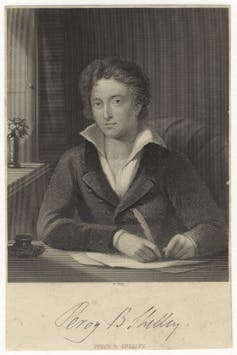It is 200 years since the poet Percy Bysshe Shelley drowned at sea at the age of 29. At the time, his life and works were considered scandalous, due in part to his reputation as a sexually liberated, vegetarian atheist, living in a reported ménage à trois. He did not achieve literary fame during his lifetime, but today he is one of the most celebrated British poets.
Shelley was writing during what is now called the Romantic period, which lasted from around 1780 to 1840. This was a time of innovative thinking and new ideas which took place in science, industry, the arts, and particularly in literature. Other Romantic writers include William Wordsworth, Jane Austen, Maria Edgeworth, and Shelley’s friend, Lord Byron.
Shelley’s notoriety began when he was publicly expelled from Oxford University for publishing an atheist pamphlet. Four years later, he courted scandal again, when he abandoned his pregnant wife and eloped with the 16-year-old Mary Wollstonecraft Godwin (later the famous author of Frankenstein) along with her stepsister, Claire Clairmont. His poetry reflected his personal notoriety. In particular, the poem ‘Laon and Cythna‘ was criticised due to its attacks on religion and descriptions of a brother-sister incestuous relationship.
Together with Mary and Claire, Shelley lived a nomadic existence, moving around the UK and across Europe, before settling in Italy. It is here that Shelley wrote some of his best-loved poems, including Adonais and began his final, unfinished poem, ‘The Triumph of Life’. It is also where Shelley died. His sailing boat, the Don Juan, sank near the Gulf of Spezia. All three passengers drowned and washed ashore days later.
Angel in death
The response to Shelley’s death was phenomenal. A leading Tory newspaper, the Courier, ran an obituary which read: “Shelley, the writer of some infidel poetry, has been drowned: now he knows whether there is a God or no.” His death became a Romantic myth that steadily grew and his poetry became increasingly popular. His wife, Mary, began this Shelleyan legacy, describing him as an “angel”, a description that endured throughout the 19th century.
By 1889, the continued fascination around Shelley’s death meant that his cremation became the subject of a painting; Louis Édouard Fournier’s ‘The Funeral of Shelley‘. The painting depicts a remarkably preserved corpse on a pyre, surrounded by his friends, including Lord Byron (who in reality went swimming in the sea during his funeral) and Mary Shelley kneeling in the background (she did not attend the funeral at all).
Shelley’s heart famously did not burn and was given to Mary. Modern physicians believe it may have calcified due to a bout of tuberculosis. Reportedly, it was found wrapped in a sheet of Shelley’s poetry after Mary’s own death in 1851 and was buried in Bournemouth alongside her.

Percy Bysshe Shelley. Photo: National Portrait Gallery, London., CC BY-NC
During the Victorian period, Shelley became an inspiration to fellow literary figures, including Robert Browning, George Eliot, Edgar Allan Poe, and Alfred, Lord Tennyson. Shelley’s reputation was sanitised to such an extent that even his old college in Oxford forgave his rebellious past and installed a monument dedicated to him in 1893. Sculpted by Edward Onslow Ford, a graceful, angelic Shelley lies on a sacrificial altar, guarded by a weeping woman.
Shelley’s Romantic reputation today
Interest in Shelley waned in the early 1900s and it wasn’t until the latter half of the century that his writings became respected due to the varied and many far reaching concerns found within them. His complex and fascinating personal life has also been the subject of a number of biographies and a source of endless fascination.
Perhaps his biggest claim to fame today is his marriage to the “mother” of science fiction, Mary Shelley. It is known that Shelley assisted his wife with her Frankenstein manuscript and the two had a collaborative literary relationship. This work, alongside the recently popular The Last Man, are certainly wider read than Shelley’s poetry, which are often limited to educational settings.
In popular culture, it is mainly through Shelley’s relationship to Mary and other Romantic figures that he is remembered. The 2017 film, Mary Shelley, starred Douglas Booth as the poet. As the title suggests, Shelley’s role is depicted as secondary to that of his wife, whose life is the centre of the story. Doctor Who, the most popular science fiction show in the UK, included Percy and Mary in their 2020 episode ‘The Haunting of Villa Diodati‘. Again, the focus was placed on the genesis of Frankenstein. Even the popular comedy series Drunk History’s 2016 segment on Shelley identified his relationships with his wife and friend, Lord Byron, as central to his appeal.
But the 200th anniversary of Shelley’s death is am important literary bicentennial. International events have been happening over the past year to mark key moments in his life, including #Shelley200. Exhibitions, including at Horsham Museum and the Shelley Conference in London, taking place this weekend, demonstrate the lasting appeal and ongoing interest in his works. For many, Shelley’s legacy lives on.
‘Ozymandias’ or ‘To A Skylark’ are a great introduction to Shelley’s poems if you want to read his works.
Amy Wilcockson, PhD Researcher, British Romantic period, University of Nottingham
This article is republished from The Conversation under a Creative Commons license. Read the original article.
